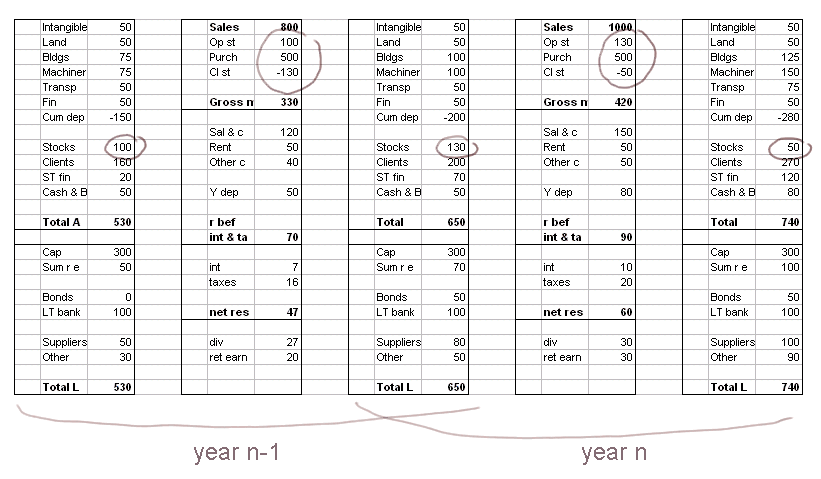General accounting
XII. 44. Stock management, the accounting viewpoint
Video
Stock management is a vast topic in distribution as well as in manufacturing. We shall only make some general comments on stocks and stock turnover from an accounting viewpoint.
We saw that the ratio called "stock turnover" shows us the efficiency in the use of stocks. Here are calculations over two years (year n-1 and year n):

The stock turnover of year n-1 = COGS / average stocks = 470 / 115 = 4,1.
And the stock turnover of year n = 580 / 90 = 6,4.
This, a priori, shows a great improvement in the stock turnover, that is in the efficiency of our use of stocks.
Of course, these figures - made up for explanation purposes - show dramatic evolutions in various figures and ratios, in particular in the stock turnover, and are not very realistic.
In real life usually ratios evolve more slowly.
In practice, we use them to detect changes that require our attention because they may signal problems.
Let's see, however, what a stock turnover improvement can mean.
Ideally, we want low stocks with respect to the COGS (i.e. a high turnover), because stocks, like every other asset, have to be financed.
Yet, we want to be able to serve demand whenever it comes.
Evolution of stock philosophy.
In the old days, before WWII, that is before the half century of progressive computerization of firms which followed, high stocks were generally viewed as something good.
That was true in manufacturing as well as in distribution:
- for distribution, think for instance of those general stores which used to be found in villages in remote areas, which had "everything".
- plants, too, during the era of Fordism, used to have high stocks of parts needed in their manufacturing process.
Toyota, in the late 40's, began to think about streamlining its supply chain, like supermarkets did (of necessity, because of perishable products).
In car assembly plants, the Japanese introduced, mostly in the 70's, the Just-in-Time system (also called "kanban").
The principles are:
- have only little stocks next to each job position of the assembly line
- have numerous daily deliveries of parts from suppliers
Sometimes, of course, this represents just a move of the stocks from the assembler to its suppliers.
But the general trend in production and in distribution is to have a small stock which turns a lot. It may cost a bit more in delivery, but it forces to have a taut manufacturing or selling process. And all in all it turns out to be beneficial.
A Japanese engineer once told me that it also revealed hidden problems on which the management should turn its attention. His sketch of biblical simplicity showed a potential teacher :-)
| hidden problems | revealed problems |
For instance nowadays:

- When we order online a computer, usually it is not yet in stock anywhere. Yet we receive it a few days later.
- In the shops of the Zara chain, the stocks are low, and the garments on display are renewed (and changed!) twice a month or even more.
Stock analysis.
In stock management, the stocks are analyzed into several categories with different turnovers:
- category A: high turnover
- category B: medium turnover
- category C: low turnover
The items which don't turn at all are called, in French, "rossignols" (= "nightingales"), because they sing at night on the shelves. Even though an aviary is a pleasant thing, you don't want too many "rossignols" in your shop.
Optimization.
In each category, we can do some mathematical optimization to determine which average stock to keep, when to reorder, and what quantity.
Indeed the total costs related to stocks include financing and reordering costs. They are a function of the frequency of reordering and of the quantity reordered. This leads to the calculation of the EOQ (= economic order quantity).
Stock analysis and stock optimization pertain to "stock management" as such. Here we only take a quick glance from an accounting viewpoint.
Low stocks are "ideal", except when they signal a problem.
Indeed the firm may have low stocks not because it manages them well, but because it can no longer pay for normal operations and it is actually selling off its assets.

For instance, badly managed bars may have little stocks because they are chronically out of cash and suppliers impose immediate cash payment of deliveries of beer kegs and other supplies of beverages. (You may say that this imposes efficient stock management... but more to the point it usually is the beginning of the end of the bar.)
To summarize:
- the ratio "stock turnover" (like all ratios) is crude and must be handled with care
- fundamentally, a significant increase of this ratio signals something:
- either better stock management
- or difficulties and the selling-off of assets



